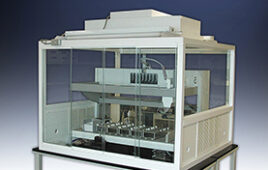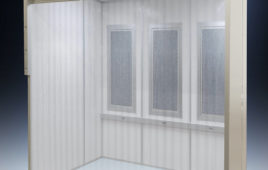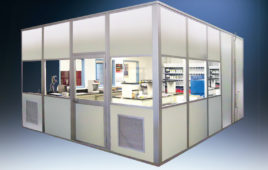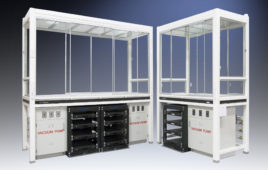Q: Can you provide an overview of how best to keep a cleanroom clean?
A: “Cleanliness is next to godliness.” John Wesley, 1778
True story: A colleague once faced the challenge of a sitting Vice President of the United States requesting an opportunity to visit the company’s manufacturing facility – including a tour inside the cleanroom. Management agreed; game on. For more than a week, White House and Secret Service advance teams worked with the company’s facilities, communications, security, and government relations staff, planning the Vice President’s trip down technology lane, in minute detail. All went well until the senior Secret Service contingent arrived, detailing final requirements which included an explosives sniffing dog inspecting the cleanroom just prior to the Vice President’s arrival.
I have no idea what a typical dog hair measures, but we’ve all been taught that a human hair clocks in at 75-100 microns diameter. And we all know that 0.5 micron particles can cause huge problems in a controlled environment. A dog is not a cleanroom’s best friend.
While the Secret Service request may be an extreme example, every facilities engineer faces the responsibility of “keeping the cleanroom clean.” What follows is a high level overview of some basics to keep in play.
Contamination, contamination everywhere
Bomb sniffing canines aside, the world is a dirty place – highly incompatible with clean manufacturing or research requirements whether in life sciences, medical device, electronics, or other specialized manufacturing fields. Fortunately, we humans are much more tolerant of this dirty world where typical office environments hold between 500,000 to 1,000,000 particles measuring 0.5 microns or larger per cubic foot of air.
Pretty ugly in comparison to some common cleanroom classifications and their maximum 0.5 micron contaminant levels:
- ISO 03 (Class 1): No more than 1 particle/cubic foot of air;
- ISO 05 (Class 100): No more than 100 particles/cubic foot of air;
- ISO 06 (Class 1,000): No more than 1,000 particles/cubic foot of air;
- ISO 07 (Class 10,000): No more than 10,000 particles/cubic foot of air.
While 0.5 microns is a handy measure for purposes of this article, many industries must control to smaller particles, while also controlling for bacterial and other microbial components.
Contamination is an expensive proposition, causing product lots to be scrapped, research trials to be abandoned, specialized and expensive equipment to fail, and billions of dollars to be lost.
The source of all that “filth”
“If you know the enemy and know yourself, you need not fear the result of a hundred battles. If you know yourself but not the enemy, for every victory gained you will also suffer a defeat. If you know neither the enemy nor yourself, you will succumb in every battle.” – Sun Tzu, The Art of War
While tradition holds that Sun Tzu, a brilliant Chinese general and strategist whose attributed writings are still influential today, was active in the sixth century BC, he was hardly concerned with cleanroom contamination. But today’s facilities engineer should know both the enemy (sources of contamination) and thyself (in this case, you and your organization’s employees).
I find it handy to broadly classify contamination sources into two broad categories: those emanating from the physical plant, and those from process/human actions. The first includes items like HVAC design; the cleanroom envelop and components such as flooring, wall, and ceiling
materials; and tool installation/venting. The second, more variable category includes actions such as maintenance of mechanical systems; cleaning/housekeeping; process controls; selection of support materials such as gowns, gloves, and wipes; and finally (the big variable) – operators.
Look at it as the nouns (items) and verbs (actions) of controlled environments.
Addressing the design and engineering considerations of cleanrooms – specifically the selection of floor, ceiling, and wall components; the engineering of an HVAC system within specific humidity, temperature, air velocity, direction, volume, and pressure parameters; and tool installation/venting – could be a separate article. So we’ll skip the “nouns” and focus on the “verbs” that influence keeping the clean in your cleanroom.
Whether particulate matter, film or microbial contamination, or any other contaminant, clean equates to control, and control equates to elimination or minimization. And the most efficient way to eliminate or minimize contamination is at the source.
So, here are the largest source contributors to cleanroom contamination:
- Operators and staff;
- Cleaning procedures;
- Maintenance processes;
- Process controls; and
- Materials brought into the controlled environment.
It’s not complicated if one engages common sense.
To arms
In the war against contamination, attacking these five enemies is truly a daily battle. But relentlessly targeting the “low hanging fruit” yields victory.
- People: Not unlike business in general, people are the biggest source of contamination in the cleanroom. We’re a walking contamination disaster waiting to happen, spewing skin flakes, hair, body oils, cosmetics, and lint from our clothing. And the faster we move, the more havoc we wreck: it’s widely reported that a person standing or sitting still generates 100,000 0.3 micron particles per minute, while walking at only five mph generates 10,000,000.
Employ the KISS (Keep It Simple, Stupid) method to avoid contamination from operators and staff by employing strict protocols:
- Training – it starts and ends here. Make it mandatory and frequent.
- Cosmetics, perfume, and personal products – Ban them, with clear consequences for even a first offense. Perfumes and colognes create vapors, while many cosmetics and personal products contain minerals like magnesium, calcium, iron, or silicon among other contaminant components. And this directive is targeted to both women and men – the vice president who opened our article was, according to his staff, reluctant to ditch his hair product during his proposed cleanroom visit (aka, photo-op).
- Jewelry and decorative articles – Between cosmetics and jewelry, we humans are a well decorated species. But every article is a source of potential contamination. Leave them behind, or keep minimal articles underneath gowns and gloves, never to see the cleanroom light.
- Gowning and glove protocol – There’s a right way, and a wrong way, to gown and glove up. It must be the right way 100% of the time. And never allow gowns or gloves worn outside the cleanroom to reenter.
- Illnesses – Keep ill employees home, or outside the cleanroom.
- Cleaning: Whether the housekeeping function is handled by staff or outsourced to contractors, the first step remains the same: clearly delineate both the standards and the process to get to clean. Make sure it’s agreed upon by all applicable parties.
And while it may be stating the obvious, it’s important to determine exactly what constitutes clean. Acceptable particulate and bacterial/microbial counts? Who will be tasked with taking measurements, and at what frequencies? Which cleaning tools and compounds are compatible with the manufacturing or research operations? Exactly when and how can the cleanroom best be maintained? At what frequency will a “deep cleaning” be required? Develop an inviolable daily and weekly cleaning schedule.
- Maintenance: Regardless of how well engineered your cleanroom may be, failing to maintain its systems sets the stage for contamination. No need to elaborate the point that it’s important to keep your HVAC and other systems operating to design standards.
- Process controls: Your processes, and product, can generate significant contamination. Vibrating tools produce friction, and friction produces minute particles. The products in production create by-products of their own, including flakes, metallic, and gases. Tool set exhaust carries its own particulate contamination. In short, the business of clean manufacturing is rather dirty. Proper design of equipment chaseways eliminates a large portion of the challenge – for both exhaust and maintenance/servicing.
- Materials: People aren’t the only problematic introduction into the controlled environment. To operate successfully, a grocery list of materials must be brought into the cleanroom, such as paper, writing instruments, cleaning supplies, bunny suits, gloves, and wipes, to name a few. Develop an approved list, and review it on a regular basis as new materials are offered. Keep unintended side effects in mind: the wrong consumables can increase the occurrences of electrostatic discharge, for example.
In the final analysis, common sense rules, whether developing a cleaning schedule or denying a proposal to bring a bomb sniffing canine into your cleanroom.
Richard Bilodeau, PE, is director of engineering at SMRT Architects and Engineers (www.smrtinc.com). His 30 year career includes plant engineering positions in clean manufacturing. Richard has engineered, designed, operated, and supervised the construction of numerous controlled environments and labs for advanced technology, life sciences, industrial, healthcare, academic, and corporate clients. Dick can be reached at [email protected] or [email protected].
This article appeared in the January/February 2015 issue of Controlled Environments.




